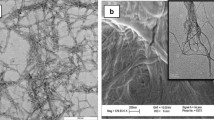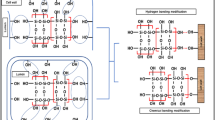
Overview
Emerging nanomaterials in forestry products
Clear description of fundamental of nano-materials
A reliable source for developing new cellulose-based materials
Access this book
Tax calculation will be finalised at checkout
Other ways to access
About this book
Similar content being viewed by others
Keywords
Table of contents (10 chapters)
-
Front Matter
-
Back Matter
Editors and Affiliations
About the editors
Hamid R. Taghiyari main area of expertise is fluid flow and permeability in wood and wood-based composites, wood modification techniques, and utilization of nanomaterials in wood and wood-based composites. He has intensively worked on the effects of different nanomaterials on properties of solid wood (different species), and composite panels as well, over the last two decades. The nanomaterials he worked with started with nanometals (including silver, copper, zinc oxide); soon he turned to minerals as they are more abundant, cheaper, and with lower environmental hazards. The results of his studies have been published in a wide range of academic journals. He had the privilege of mentoring over 40 post-graduate students, mainly on utilization of nanomaterials to improve different properties in solid wood, and wood-based composite panels as well, including physical and mechanical properties, fire retardants, and biological durability against wood-deteriorating fungi and insects.
Jeffrey J. Morrell holds BSc and PhD degrees form the State University of New York College of Environmental Science and Forestry in Forest Biology and Forest Pathology and Mycology, respectively, as well as an MSc from Pennsylvania State University in Plant Pathology (nematology). He has over 40 years of experience in the field of wood science concentrating on durability. His research has spanned the field from understanding the fungal sequences during decay to the use of various chemicals to minimize fungal attack and ultimately to the movement and fate of preservatives, especially in aquatic environments. He has been fortunate to mentor over 50 post-graduate students. He is currently Director of the National Centre for Timber Durability and Design Life at the University of the Sunshine Coast in Brisbane, Australia and is actively engaged in research related to enhancing the performance of cellulosic materials.
Azamal Husen served as Professor & Head, Department of Biology, University of Gondar, Ethiopia and is a Foreign Delegate at Wolaita Sodo University, Wolaita, Ethiopia. He specializes in biogenic nanomaterial fabrication and application, plant responses to environmental stresses and nanomaterials at the physiological, biochemical and molecular levels, herbal medicine, and clonal propagation for improvement of tree species, and has published over 175 research articles. He is contributed to R&D projects of World Bank, ICAR, ICFRE, JBIC etc. He is on the advisory board of Cambridge Scholars Publishing, UK. Husen has been on the Editorial Board and the panel of reviewers of several reputed journals. He is a Fellow of the Plantae group of the American Society of Plant Biologists, and a Member of the International Society of Root Research, Asian Council of Science Editors, and INPST. He is Editor-in-Chief of the American Journal of Plant Physiology, and a Series Editor of Exploring Medicinal Plants (Taylor & Francis Group, USA); Plant Biology, Sustainability, and Climate Change (Elsevier, USA); and Smart Nanomaterials Technology (Springer Nature, Singapore).
Bibliographic Information
Book Title: Emerging Nanomaterials
Book Subtitle: Opportunities and Challenges in Forestry Sectors
Editors: Hamid R. Taghiyari, Jeffrey J. Morrell, Azamal Husen
DOI: https://doi.org/10.1007/978-3-031-17378-3
Publisher: Springer Cham
eBook Packages: Biomedical and Life Sciences, Biomedical and Life Sciences (R0)
Copyright Information: The Editor(s) (if applicable) and The Author(s), under exclusive license to Springer Nature Switzerland AG 2023
Hardcover ISBN: 978-3-031-17377-6Published: 06 December 2022
Softcover ISBN: 978-3-031-17380-6Published: 06 December 2023
eBook ISBN: 978-3-031-17378-3Published: 05 December 2022
Edition Number: 1
Number of Pages: X, 362
Number of Illustrations: 30 b/w illustrations, 55 illustrations in colour
Topics: Forestry, Nanotechnology, Plant Sciences, Biotechnology, Anatomy, Genetics and Genomics



